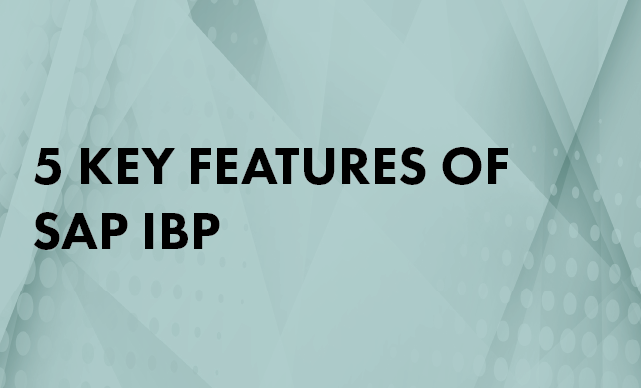As a technology enthusiast, you also need to be aware of the competitive landscape impact of new solutions and offerings that emerge in the market. The system dynamics of technology market for most segments is very fluid now. Anytime a major player launches a product in an existing segment, it flexes the dynamics of the entire segment. In this article, we will analyze how AWS Supply Chain, a product that AWV unveiled during Re:invent 2022, impacts SAP flagship supply chain planning solution, SAP IBP (Integrated Business Planning), from a marketing positioning perspective. The scope of this article aligns very well with our February 2023 report,
Supply Chain Resiliency and Agility Through Analytics, Automation and Effective Data Management.
What is AWS Supply Chain Solution?
The need for comprehensive and integrated cloud based planning solutions emerged as a key need in our recent research report,
Supply Chain Planning in The Cloud. In SAP technology ecosystem, SAP IBP rules this space. AWS Supply Chain may have the potential to disrupt that.
AWS Supply Chain is a cloud-based solution that offers a plethora of features that can help address supply chain challenges organizations face today. At a high-level, it provides the three powerful capabilities of data integration, analytics and advanced analytics, and supply chain collaboration, into one single solution. As you may have already noticed, this combination of planning portfolio offered in AWS Supply Chain is a USP of SAP IBP as well.
What Does the High-Level Architecture Look Like for This Solution?
At a high level, the architecture can be categorized into four components. The architecture from AWS product page is shown in illustration 1.
- Data integration
- Real-time visibility
- Analytics
- Collaboration
Illustration 1: A high-level architecture of AWS Supply Chain offering
 Source: AWS product page
Source: AWS product page
You can find more about the product here:
https://aws.amazon.com/aws-supply-chain/
How Can AWS Supply Chain Solution Impact SAP IBP GTM Strategy?
If you are familiar with SAP IBP features and functionalities, you will notice certain comparative aspects like:
- Both can plug into SAP S/4HANA, eliminating need for replatforming
- Both can be leveraged for developing control towers
- Both have robust inventory planning and optimization capabilities
- Both have demand management and planning capabilities
- Both have repositories of rich algorithms for predictive analytics
AWS Supply Chain tool has a more powerful data integration feature. We will explore later in the article if that is a strong advantage.
Below are some strategic implications that SAP IBP marketing strategists probably currently have on their mind:
A closely competing product: I will go to the extent of saying that based on adoption, it has the capability of being one of the top competing products of SAP IBP. The big driver behind will not be the features and functionalities but:
- How seamlessly the solution plugs and plays with SAP S/4HANA. A key USP of SAP IBP is the seamless integration with SAP technologies. Providing the same level of seamless integration will be a key feature.
- How effectively AWS Supply Chain helps with data integration. Unless clients invest in some additional SAP technologies, integrating data sources is a pain that clients address by often investing in stand alone data integration tools. If AWS Supply Chain can make the process easy and eliminate the need for investing in additional capabilities to build a centralized data repository for supply chain, it will have a major advantage.
Rethinking the partnership: SAP has strong partnership in the SAP on AWS offering. Partnerships in the world of technology are always tricky. Both sides in the partnership have the opportunity to “learn” what the other side offers in terms of value. Partnerships happen because no one solution exists that taps into both technology offerings. Hence, two or more companies come together to create a complete offering. However, it is not uncommon in the history of the corporate world, that one partner figures out how to offer the complete end-to-end value. SAP is safe from this angel though as far as partnership with AWS goes. If it were Microsoft, which has its own cloud ERP offering, the partnership would need to have been re-envisioned. AWS currently does not have any offering like that and I do not see a reason why they would enter that space.
But AWS is a hyperscaler with a deep an rich portfolio of cloud based solutions, like its other key competitor, Microsoft Azure. And this is where SAP BTP comes into picture. As you may have read "Cloud is just someone else's computer". The value adds in the offering as well as the value that investing companies can generate leveraging cloud is the real differentiator. SAP BTP core USP is that provides a cloud-based technology platform that allows you to build an intelligent enterprise leveraging SAP technology portfolio as well as bolt-on partner applications. Now currently, you can use your preferred cloud while interoperating with your existing IT infrastructure but let us look at it from other lens.
AWS and Azure are widely leveraged cloud services and despite recent slowdowns in growth, their penetration will continue to increase. If you are way deeply invested in AWS or Azure infrastructure, and if these providers offer a capability that is similar to SAP BTP (and you have not invested in BTP yet), what will you choose?
There is another critical aspect to it that SAP should consider. Taking AWS marketplace as an example- If you explore the marketplace, it has ERP offerings as well, that promise more agility and flexibility. We do not evaluate ERP offerings beyond SAP so can not comment how good or bad these solutions are. But the crux here is that as clients get more and more deeply invested in these hyperscalers, SAP needs to be worried.
Of course, all of this can be addressed with a robust GTM strategy. While we started the article with SAP IBP, as you can see, we delved into SAP BTP eventually. And this is the key that SAP needs to keep at the core of its marketing strategy:
SAP can not have siloed marketing, GTM and solutioning play anymore.
The technology market where players were kings in certain segments, and were focused segment-wise is yesteryears strategy. Proliferation of tech technology and rapidly lowering of barriers to entry in technology solution offerings space means that you need to go beyond the segment focused approach to deliver an end-to-end and integrated solution. While it is obvious that SAP is already pushing this strategy, it needs to accelerate it.
It also needs to lock those who have not yet invested in its comprehensive portfolio of offerings beyond ERP. There are various strategies that SAP can play with to attain that objective. The gist is to make it less and less alluring to move to other solutions that promise aspects that address challenges with SAP's customers face.
In this article, we shared why every time a solution offering, like AWS Supply Chain, launches in the market, it flexes the dynamics of the overall technology ecosystem. Technology strategy is becoming more and more complicated for providers but a robust combination of solutioning strategy and marketing can address all these challenges.
 Source: AWS product page
You can find more about the product here:
Source: AWS product page
You can find more about the product here: 








